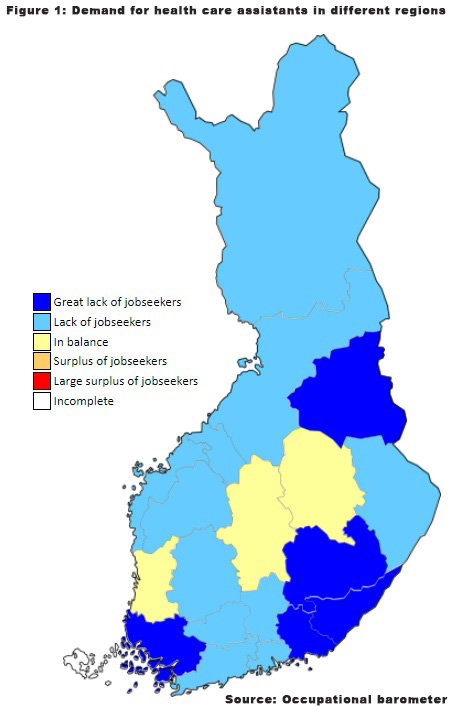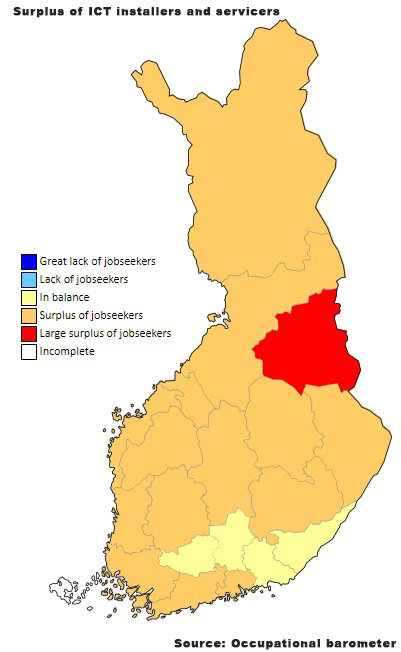According to the Knowledge Forecasting Forum, an expert body in the Finnish National Agency for Education (OPH), by the year 2035 there will be a huge need (estimated at over 60,000) for trained workers.
This means that in the next 15 years Finland will need skilled workers to run the various public and private sectors smoothly, which will be difficult to achieve with the current aging population and decline in birth rates.
Many countries in the West have faced similar situations and made well-structured policies to attract talented workers from abroad to retain the existing talent in their country.
The professional or occupational barometer of Finland (ammattibarometri) has a well-managed database. It has grouped the need of workers based on occupations, regions and levels of shortage.
 The occupational barometer divides Finland into approximately 70 regions. It elaborates each region in terms of shortage and surplus workforce based on various occupations. The occupational barometer also has an overall national picture of shortage or surplus workforce. According to the data of employment service statistics (MEE) provided to the occupational barometer, the top 15 occupations face a huge demand for labour.
The occupational barometer divides Finland into approximately 70 regions. It elaborates each region in terms of shortage and surplus workforce based on various occupations. The occupational barometer also has an overall national picture of shortage or surplus workforce. According to the data of employment service statistics (MEE) provided to the occupational barometer, the top 15 occupations face a huge demand for labour.
These professions include speech therapists, service industry workers (cleaners, restaurant and hotel helpers, etc.), specialist medical practitioners, general medical practitioners, childhood educators, social work professionals, nursing associate professionals, contact centre salespersons, cooks, commercial sales representatives, construction supervisors, dentists, domestic helpers, healthcare assistants (Figure 1) and metal workers.
The overall workforce data for Finland also shows the 15 bottom professions in terms of surplus of job seekers. These professions include secretaries, dressmakers, admin officers, graphic designers, ICT user support technicians, ICT installers and servicers (Figure 2), journalists, printers, pre-press technicians, anthropologists, garment designers, marketing professionals, library clerks, travel consultants and teacher’s aides.

It is important to note that there are imposing talks going on since last decade about the lack of ICT workers, though according to the occupational barometer, there is a surplus of ICT installers and servicers and ICT user support technicians.
The reason behind this confusion is the huge diversity of ICT skills itself. The data for application programmer (ICT) professionals tell a different story and show they are in higher demand in many regions in Finland. This example tells us that it is very important to dissect each profession carefully before making any policy regarding the demand/surplus of skilled workers.
Additionally, the data from the occupational barometer is a great starting point for analysing the shortage of workers based on skills and designing the relevant strategies to overcome the huge gap by 2035.
Countries that attract most of the international talent from around the world such as the USA, Canada, UK and Australia design specialized immigration and integration programmes. This strategy helps these countries not only attract the required talent but also retain that talent within the country.
These attractive destination countries for skilled workers publish and update positive lists (list of specified professions in high demand) of required immigrants based on the occupation on their official immigration websites. Any applicant whose occupation is on the positive list gets extra points, relaxation and facilitation to be eligible to immigrate.
Finland's best selling point
Finland has a great advantage and reputation internationally as it has always been placed in the top ten countries in terms of safety, happiness, innovation and education system during the last two decades. This is the biggest selling point for the country in its attempt to attract and retain talent.
However, due to many reasons, Finland is still not a preferred destination for talented workers. Finnish universities attract thousands of students around the world each year but are unable to retain most of the graduates due to poor employability rates of foreign-origin persons.
Many government bodies are working on this issue to attract more talent. Nevertheless, it is important to note that Finland already has the talent in the form of graduates.
Finnish universities attract thousands of students around the world each year but are unable to retain most of the graduates due to poor employability rates of foreign-origin persons
Finnish universities every year do hard work to find talented people for different international degree programmes. It is a challenging process to get into a Finnish institute for international students, especially for non-European students. Once all these bright students pass all of the steps of admission and the tough never-ending process of Migri, Finland then has a good set of people in its universities.
These students mostly have useful diverse experience from their home countries and after getting Finnish degrees, they are the ideal group of skilled workers to stay and work in Finland. However, most of them are not able to find jobs in their own professions and leave the country or enter into the never-ending cycle of odd jobs to survive due to many family responsibilities.
Finnish companies and international students are both somehow responsible for this particular situation. Companies do not want to compromise on their tough guidelines to hire highly skilled immigrant workers due to their weak language skills. On the other hand, talented graduates lack social and professional networking skills, which are vital to get hired in Finland.
Public and private bodies such as Business Finland, the Chambers of Commerce, Talent Boost in different cities, entrepreneur promoting organizations, employment offices (TE), Ministry of Economic Affairs and Employment, labour unions, private employment service providers, universities and polytechnic schools and society itself can pull together to not only attract the talent from abroad but also accommodate well the existing talent in Finland.
This will help to get a tremendous amount of benefits from skilled workers, boosting economic growth and combating the upcoming shortages of labour in the future.
*Afnan Zafar, Ph-D., is a research fellow at the University of Vaasa (Finland).










